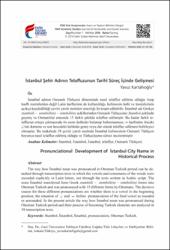| dc.contributor.author | Kartallıoğlu, Yavuz | |
| dc.date.accessioned | 2016-07-01T07:35:37Z | |
| dc.date.available | 2016-07-01T07:35:37Z | |
| dc.date.issued | 2016-06 | |
| dc.identifier.citation | KARTALLIOĞLU, Yavuz. "İstanbul Şehir Adının Telaffuzunun Tarihî Süreç İçinde Gelişmesi." FSM İlmî Araştırmalar İnsan ve Toplum Bilimleri Dergisi, 7 (2016): 119-136. | en_US |
| dc.identifier.uri | http://dergi.fsm.edu.tr/index.php/ia/article/view/728 | |
| dc.identifier.uri | https://hdl.handle.net/11352/2346 | |
| dc.description.abstract | İstanbul adının Osmanlı Türkçesi döneminde nasıl telaffuz edilmiş olduğu Arap
harfli metinlerden değil Latin harflerinin de kullanıldığı, kelimenin ünlü ve ünsüzlerinin
açıkça kaydedildiği çeviri yazılı metinler aracılığı ile tespit edilebilir. İstanbul adı Grekçe
stambóli ~ stembóli(n) ~ stimbóli(n) şekillerinden Osmanlı Türkçesine Stambol şeklinde
geçmiş ve Osmanlılar arasında 15 farklı şekilde telaffuz edilmiştir. Bu kadar farklı telaffuzun
ortaya çıkmasında ön seste ünlünün bulunup bulunmaması, ب harfinden önceki
ن’nin durumu ve son hecedeki ünlünün geniş veya dar olarak telaffuz edilmesi belirleyici
olmuştur. Bu makalede 38 çeviri yazılı metinde İstanbul kelimesinin Osmanlı Türkçesi
boyunca nasıl telaffuz edilmiş olduğu ve Türkçeleşme süreci incelenmiştir. | en_US |
| dc.description.abstract | The way how İstanbul noun was pronounced in Ottoman Turkish period can be detached
through transcription texts in which the vowels and consonants of the words were
recorded explicitly in Latin letters, not through the texts written in Arabic script. The
noun İstanbul transferred form Greek stambóli ~ stembóli(n) ~ stimbóli(n) forms into
Ottoman Turkish and was pronounced with 15 different forms by Ottomans. The decisive
reason for these different pronunciations are whether there is a vowel in the beginning
position, the situation of ن and ب before pronunciation of the final vowel as rounded
or unrounded. In the present article the way how İstanbul noun was pronounced during
Ottoman Turkish period and their process of becoming Turkish elements are analyzed in
38 transcription texts. | en_US |
| dc.language.iso | tur | en_US |
| dc.publisher | FSM Vakıf Üniversitesi | en_US |
| dc.rights | info:eu-repo/semantics/openAccess | en_US |
| dc.subject | Stambol | en_US |
| dc.subject | İstambol | en_US |
| dc.subject | İstanbul | en_US |
| dc.subject | Telaffuz | en_US |
| dc.subject | Osmanlı Türkçesi | en_US |
| dc.subject | Pronunciation | en_US |
| dc.subject | Ottoman Turkish | en_US |
| dc.title | İstanbul Şehir Adının Telaffuzunun Tarihî Süreç İçinde Gelişmesi | en_US |
| dc.title.alternative | Pronunciational Development of İstanbul City Name in Historical Process | en_US |
| dc.type | article | en_US |
| dc.contributor.department | FSM Vakıf Üniversitesi, FSM İlmî Araştırmalar İnsan ve Toplum Bilimleri Dergisi | en_US |
| dc.relation.publicationcategory | Makale - Ulusal Hakemli Dergi - Kurum Öğretim Elemanı | en_US |



















